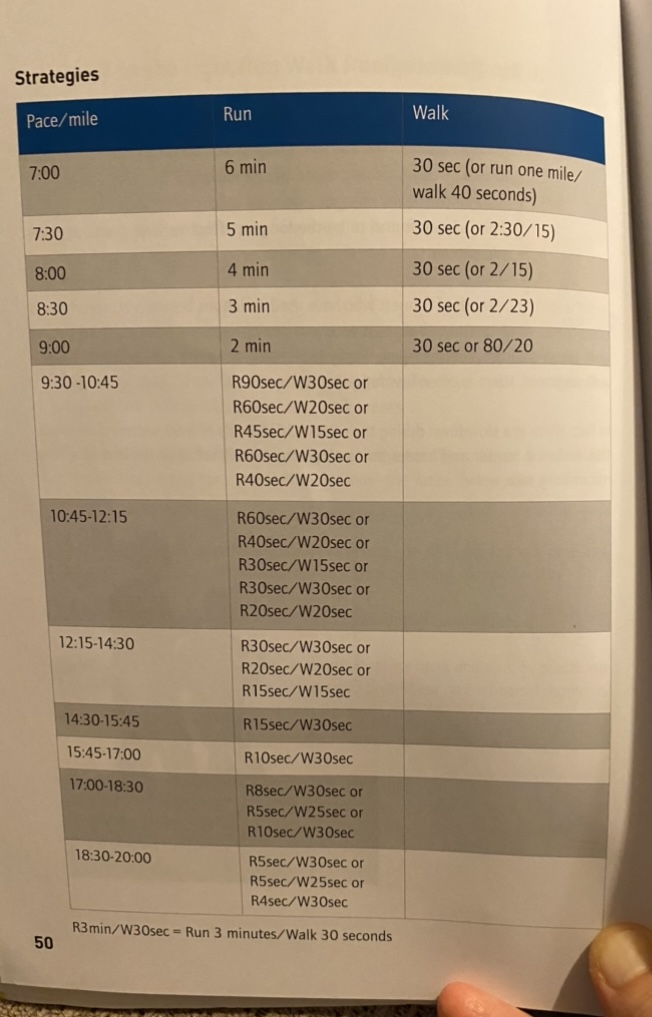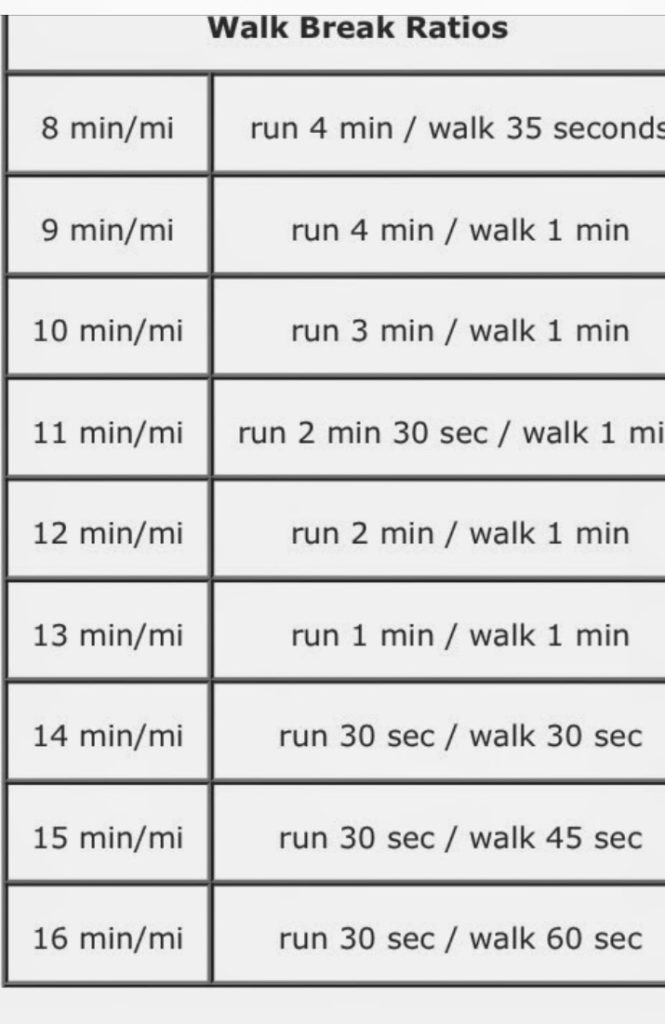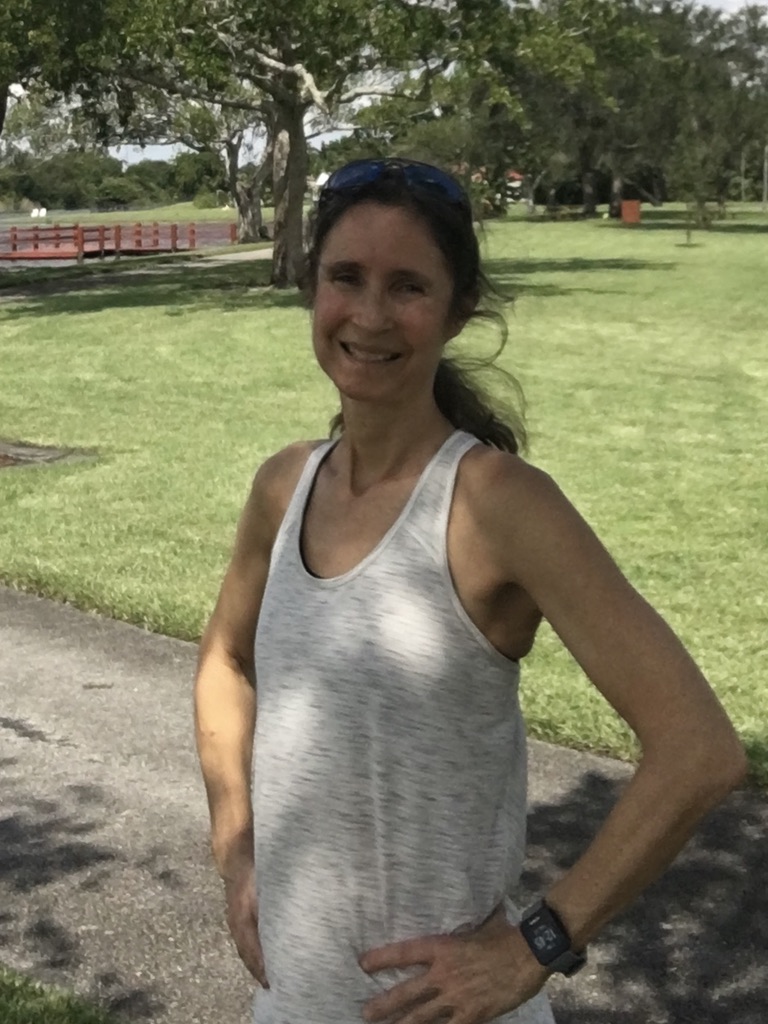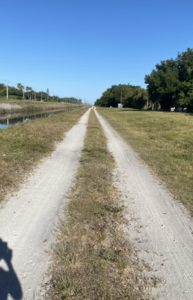I recently read Jeff Galloway’s book. The Run Walk Run Method. “Run Walk Run” is Jeff’s trademarked term for his method of run/walk intervals, but to make it easier I’ll refer to it as RWR, or as Liz calls it, “jeffing,” ha ha. I’ve been trying out the RWR method for the last couple of weeks- when I’ve been doing it longer I’ll do a post on how it’s working for me. This is mostly a review of the book.
I have a couple negatives which I’m just going to get out of the way. The first is, I felt this book was mostly geared towards beginners. There’s all sorts of statements like “become a runner without beginner’s aches and pains,” and “motivates beginners to get off the couch and run.” Even the testimonials at the end are full of “I started running again using your method after twenty sedentary years!”
I have NO DOUBT that this method is great for beginners, sedentary people, people who are very overweight or recovering from cancer or open heart surgery; but I’m coming to it from a different perspective. I’m fighting my personal bias that tells me this is a “downgrade” for me, and I wanted evidence that isn’t true. I would have liked more details of Galloway’s own story- he was an Olympic runner before switching to a run/walk method. I’m sure there are plenty of other stories like that, and I wish the book was more focused on that angle.
The other negative is probably coming, again, from my personal bias. The whole time I was reading I felt slightly defensive, and it was only afterwards that I figured out why. You know how, as runners, we’re constantly being told that “running is bad for you?” So annoying! In a way I felt like this book was taking that stance. Galloway is basically saying “Running is bad for you (unless you do my Run Walk Run method.)” I know- that’s an exaggeration. He doesn’t actually SAY that. But he is saying that run-walk intervals are better than straight running, which made me want to argue with him.
HOWEVER! Let’s just imagine how that argument would go. Me: “I don’t agree with you that continuous running is bad for you!” Jeff: “Oh really? How has that been working out for you lately?” Me: “Er… fine. I’ll try your method.”
And that’s basically where I’m at.
So now let’s talk about the good things in this book. Among the benefits of RWR (according to Jeff) are fewer injuries, less fatigue at the end of long runs and races, improved race times (in some cases) and a few points I didn’t expect.
One thing he recommends is…. running through injuries. NOW we’re on the same page! Of course, with a caveat. You can’t do it with every injury. But the rule of thumb would be, if you can walk, then you can do RWR intervals, even if you’re just starting with 5 seconds running/55 seconds walking.
Coincidentally, even before I even read this book, that’s exactly what I was doing with my current hamstring issue. I just couldn’t stand the thought of getting back in the pool, so I went out determined to cover a three mile route however I could. At first I was only running for about ten or twenty steps before I had to walk, but I finished three miles like that. Each time I went out I ran more and walked less, until I got to the point I’m at now (more about that in a bit.)
Galloway would say that the physical benefits of doing this include increased blood flow to the injured area, which speeds healing. But the mental benefits are even bigger. Instead of feeling helpless and depressed in the face of an injury, you can take control of the situation. Even if you end up walking the entire time, fine- next time you can insert some short running intervals. If you’ve made progress but the injury starts to hurt again, no problem. You can choose to adjust your run/walk intervals accordingly. I can personally attest that it worked for me, and this was my favorite chapter of the book.
Another benefit- according to Galloway- of RWR is the way your body uses endorphins. Galloway claims that RWR intervals lessen the fatigue and irritation to your body, so endorphins that would normally be used to kill pain can now go to boosting your mood, which means you’ll feel even better after a RWR session that you would from continuous running. I can’t say I’ve noticed that- I get a huge boost of endorphins both ways- but I thought it was an interesting point.
So, now for the actual RWR intervals. Surprisingly, Galloway says that runners have found they have just as much recovery from a 20-30 second walk break as from a longer walk. In a 60 second walk break, there can be a significant slowdown in the second half, and it can be harder to start running again. He likes shorter running and walking intervals. For example, if a runner is doing 4 minutes running/1 minute walking, he would recommend instead doing 2 minutes running/30 seconds walking. Here’s the pace chart from the book:

In case you don’t know your mile pace, there’s an entire chapter dedicated to the “magic mile,” explaining in detail how to do a mile time trial. (Again, I felt this was geared towards beginners.)
If you go online, you can find some different RWR pace calculators, like this one:

This chart obviously shows longer walking breaks. I think you can just experiment to see what works best for you. Although I’m not running an 8 minute mile pace, I am doing the RWR interval of 4 minutes running/30 seconds walking. I really don’t want to run any less than that, and I also like the short 30 second walk break. But I might experiment with different intervals in the future, just for fun.
Would I recommend this book? Yes… if you’re a beginner. Otherwise, I think you could find most of the information you need online, including how to set your watch for the appropriate intervals- you definitely want your watch to alert you when to run and walk.
So far I’m enjoying my “jeffing.” Will I do it forever? I don’t know, but it’s perfect for where I’m at right now.
Thanks as always to Kim and Zenaida for hosting Tuesday Topics!






30 Responses
Did you write this for me?? LOL
I feel the same way but not because of injury but because it makes long runs easier and I don’t want an injury.
I still can’t get my head around doing it in a race.
My friend did during our last half and we finished at the same time but she didn’t suffer through the last miles. I did!!!
I know, Darlene- I haven’t figured out what I’ll do in a race yet. If I think my pace will be just as fast (or faster) I’m going to try it. Maybe I’ll try it for our half in February!
Thanks for this review, Jenny!
This is very useful right now with my Achilles thing. I have stopped running completely, but maybe I just start to do RWR. The point about the blood flow speeding healing is convincing. And I like the mental benefits, too!
Even a mini-run of a few seconds is better than nothing at all!
Yes! You wouldn’t think a mini-run would even be worth it, but it is- at least it was, for me.
This is very interesting Jenny, thanks for sharing.
First, I like his thoughts about the mental benefits; from following your journey I know that running is of utmost importance to your mental and emotional health. So I really like that he incorporates that into the book. I think it’s something that isn’t discussed as much in fitness literature. So much is geared towards changing body size and shape, and so little towards obtaining inner calm and peace. I like running but I like other fitness as well, and I know that missing a cardio workout in any capacity isn’t great for my own mental health. I feel that for you, though, it’s running or nothing, when it comes to cardio (I know you do lots of strength, etc). So the thought that there would be a method that helps you when you’re injured is great.
I think most of those books are geared towards beginners, which is great, but as you say it would be nice to see an experienced runner discuss the journey to a different methodology. I read a book called Shut Up and Run and it was very much a beginner’s book, but it also showed a really good fitness journey for the author.
At this stage of my life, I know that running isn’t going to change the way my body looks. It’s all about the mental benefits. And you’re right- I’ve tried, but no other cardio gives me the mental benefits that running does. So… it’s time to give jeffing a try!
I feel the same way as an experience runner. I know it’s beneficial for me but my problem is that lots of “experienced” runners use this method and don’t talk about it! They show off these great times and don’t talk about how they often take walk breaks. It turns out that I was the only one of my group trying to get through summer runs without walk breaks. Runs are much more enjoyable in this heat with walk breaks and I wish I had known to use them a lot sooner!
I agree 100%. I’ve been suffering through sweltering summer runs for years (you’re in Texas and I’m in Florida- both unpleasant places to run in the summer) and I’m just now discovering how much easier it is with walking breaks. AND, my paces are the same! If my pace is the same, why not make it more comfortable???
Whaaaaat! I had no idea that you were supposed to determine your RW intervals by your running speed! I’m making a note for when/if I ever go back to running. Yes I suppose I could read the book but I’d much rather read your recap!
Ha ha, yes, don’t bother with the book. I’ll post future updates on my experience with jeffing as time goes on.
Honestly, I feel like no one needs to read the book now! Between what you wrote and what the charts say, I think anyone who is interested in this system would have it down. Which makes me wonder exactly what he wrote in a book-length form. Ha!
Yes, that’s the other thing I should have written- I felt like the book was very repetitive.
I am glad the PT I saw after Will told me to do run/walk intervals. It helped make my return to running much more enjoyable and gradual. I kept increasing the time running and kept the walking to 30 seconds, so I started with 1 minute of running, 30 sec walking. When I saw her each week she’d tell me how to adjust it. I got back to continuously running within a couple of months and the process was more enjoyable. I would break the rules and run as long as I could when I ran with my neighbor because I did not want to slow her down. I didn’t know her that well then but now I know she would have been fine taking as many walk breaks as I needed – she was just happy to have the company.
Wow, that’s a great PT! And interesting that you kept the walks to 30 seconds. At first I thought that interval was too short, but now I think it’s perfect.
I can see how you might be “offended” by some of the wording lol. I did 4:1 intervals for a long time and they really helped me after coming back from an injury. I got stronger and faster. It is counter intuitive but it really does work. He has a huge following that swears by it!
Yes, I think those of us who have been running for years have a lot of resistance to walking at all. But so many people- like you- have said it worked for them.
Thanks for the awesome review! I haven’t heard of this book before but I am a big fan of the run walk run method.
Well now that you’ve read my review you won’t need to read the book! You’re definitely already experienced with the method.
This is a great review, Jenny! I’ve probably told you (or at least I’ve written it numerous times, LOL) that I almost always run based on feel. I hate being a slave to a watch (even my shiny new Garmin), so I just run. I did do 2-30 second walk breaks at each of the mile marks of my 8-mile run last weekend. I can’t really tell if that made things “easier” or not. I have some hammy tightness, so it’s nothing really debilitating, so it’ll take awhile before I get more comfortable with “all the walking.” I ran the Chicago Hot Chocolate 15K, last November, with Deborah…and we used her R/W intervals and things went really well (but I also had her along for conversation, laughs and fun). Stay tuned!
This is sooooo fascinating to me. I honestly had NO idea “serious” runners did this. It makes so much sense, though, for injury prevention and I can also see it making long runs much more sustainable.
That said, the really short intervals seem like a nightmare. I’m a slow runner, so his suggestion for my pace would be 90 seconds of running and then 30 seconds of walking (or even all the way down to only 40 seconds of running). I saw for very slow mile paces, he even goes down to 4secR/30secW. That sounds miserable – all that stopping and starting! But, what do I know. Maybe it wouldn’t be so bad?!
I did 4:1 based on feel last time, but think something like 3R/30sec W might be a better fit for me right now. I haven’t run solo since I tried the 4:1, and RWR seems like a weird thing to do when running with someone else. Though, my splits were better than normal when I did the 4:1…so maybe I wouldn’t end up behind in the end?! I’m doing a run with my hubby tomorrow morning and I’m going to try to do our 5 km route with a 3minR/30secW. What’s the worst that can happen?
Yes, I really can’t imagine doing those shorter intervals. That’s why I’m doing the 8 minute mile pace intervals (even though I’m not running 8 minute miles!) At some point I’ll try different intervals just out of curiosity- but right now the 4 minutes/30 seconds is working for me. I’ll be interested to hear how your run goes with the 3 min/30 sec. I definitely like the 30 second as opposed to a full minute.
I ended up doing a 2 min R/30 sec walk this morning (total 6 km) and my average split was 12 seconds FASTER per km than my continuous 5.25 km run yesterday. This shorter interval was also 3 seconds faster/km than my 4:1 interval for a 3 km run I did last week.
I’m mostly just nerding out over the fun of comparing stats of straight runs vs. those done using intervals. Will I be brave enough to do this for my upcoming 5K? Time will tell…
I’m going to try 2 min R/30 sec walk again tomorrow and then maybe try 3R/30 sec walk next week? It will be fun to compare how the various interval combos impact my splits.
I’m also going to play around with run/walk intervals just for the fun of it. But, like you, I’m wondering about doing this in a race. Won’t people laugh at me for walking after 4 minutes??? (of course, I know no one really cares. It’s all in my head so I probably just have to get over it!)
I can see how the way the book was written may be a turn off! I personally don’t use run walk because i find it hard to start running again once I stop. But I have used it when coming back from injuries. And Ive coached some runners with it. I have a runner in her 60s who was constantly injured and almost gave up running and has now been injury free for over a year and has run some of her fastest times ever. It’s worth a try!
Yes, my motto is “any running is better than no running.” I used to feel the same way about walking- too hard to get started running again. But I’m liking the 30 second walk breaks- it’s so short it barely feels like a break and is easy to run again.
Yes, the thing I get annoyed about is the beginner thing – including that beginners are slow and need the very short run intervals and that they speed up – I’ve always been slow and I enjoy a 4 min / 30 sec arrangement. So I ignore the magic mile thing. I am planning (shh don’t tell) to go in the London marathon ballot in Oct – the race is April and I know I can’t do the training running continuously so I’m going to jeff the training and the race if I get in! That’s how we use it in my circle, or for coming back from injury / slumps.
Ha ha, okay I won’t tell anyone! Yes, I can see how jeffing would be a good tool to have for all sorts of situations. I’ll be interested to hear all about your training and the race- I hope you get in!
I am glad this method has been working out for you. My coach had me doing this method. I wasn’t too crazy about it at first but then actually enjoyed the walking part. I started with 3 minutes running and 1 minute walking and moved on to 5 minute running and one minute walking.
Thank you for linking up with us!
Yes, I thought I wouldn’t like it but I’m surprised at how much I do.
Thanks for sharing your review. I could totally see how the part that is geared towards beginners would be off-putting to a seasoned runner like you and I absolutely have the same ‘defensive’ reaction when someones says running is bad for you (unless you do the run-walk method). I’d be up for an argument myself… but I think as much as it makes us feel defensive, it might make novice runners more confident that running could be “something for them”, when previously they thought they could never do it.
As you said, it all depends from what perspective you come at this book. I would appreciate though if he had taken more of a balanced stand in the middle.